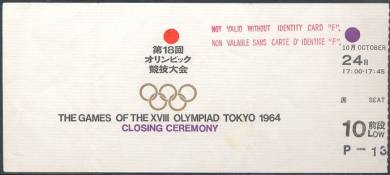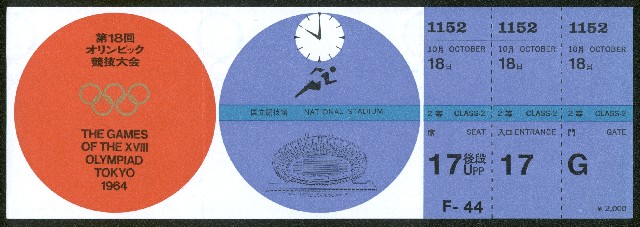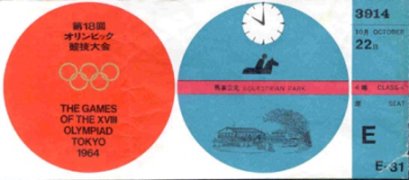Tickets
|
Ticket Design and Printing
1964 Design Mr. Hiromu Hara of the Japan Design Centre, chosen by the design consultation group for the Organizing Committe, was asked to prepare the tecket design and this was completed in March 1963. The general aim of this design was to symbolize the image of the Tokyo Olympics, and also to exemplify the Japanese concept of simplicity, while yet making it practical in the various requirements of tickets for an International Sport event of this nature. - The red circle on the left hand side of the ticke was used in all tickets as the symbol of the Tokyo Games.
- Name of event, the site and starting time were expressed graphically in the central circle. Different colours were used
for each site in this circle. In particular, golden colour - Two-thirds of the square on the right hand side was torn off as the ticket holder entered the site. In this square,
the ticket classification, number, date, entrance,
Paper used "Stereo watermark machine-made Japanese paper for security printing" was used as the paper for all tickets. Here too care was taken to preserve a Japanese impression. This paper was specially developed to give the appearance of a relief watermark, inasmuch as an actual relief watermark is prohibited by law for use other than on currency bank notes. Printing Printing was handled by two major printing companies in Japan. Actual printing was commenced in October 1963 and 2,100,000 tickets in 1.385 different varieties were completed in May 1964
Surface: The colour part consisted of four gravures. "Red" for the rising sun and "golden" for the five circles were common in all tickets. The sites were classified into six colours by area and classes of tickets were shown in seven colours. Spaces of black were made in relief printing and were printed differently accordint to the classification number, event, site, date, entrance, and seat number.
Reverse side: This was in offset printing in two colours. A plan of the site, cautions and general area indication of site were printed in different colours. In addition to the complicated pjrinting methods requiring more than ten changes and different printing machines for gravure, relief and offset, the printing programmes had to be modified due to changes in the actual seat allocations as a result of the final site planning, and alterations in the final number of available seats, seat numbers, and entrance signs after the printing had in fact begun. Some apprehension was expressed that these changes and consequent delays would cause complications, but thanks to the wholehearted cooperations of the printers, and other involved, and of the handling agencies, the first exchange of reservation applications for tickets was completed on schedule. (Source document: Official Report 1964, Vol. 1, page 413) |



